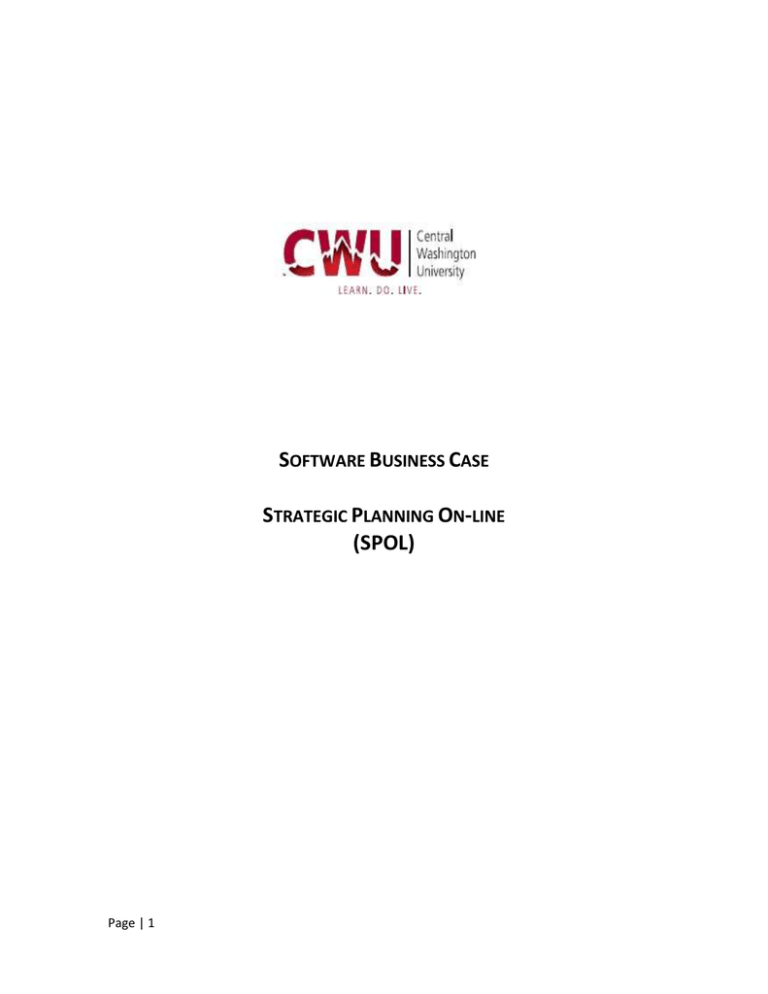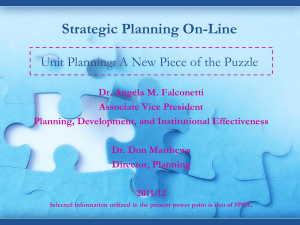Strategic Planning Online (SPOL)
advertisement

SOFTWARE BUSINESS CASE STRATEGIC PLANNING ON-LINE (SPOL) Page | 1 TABLE OF CONTENTS EXECUTIVE SUMMARY ........................................................................................................................... 3 1. Problem Definition .................................................................................................................... 3 2. Addressing Problem with CWU existing tools and products (i.e. PeopleSoft) ................................ 3 3. Organizational Impact ............................................................................................................... 4 4. Benefits .................................................................................................................................... 5 5. Strategic Alignment ................................................................................................................... 6 6. Cost .......................................................................................................................................... 7 7. Alternatives (add lines as necessary) .......................................................................................... 7 8. Timing / Schedule (add lines as necessary).................................................................................. 7 9. Technology Migration/Resource Identification ........................................................................... 8 10. Product Life/Application Sunsetting or Decommissioning ............................................................. 8 11. References ............................................................................................................................... 8 12. Recommendation ..................................................................................................................... 8 13. Approvals ................................................................................................................................. 9 Page | 2 EXECUTIVE SUMMARY Two very recent outside reviews have found CWU lacking in its planning ability and focus. Central Washington University’s NWCCU Accreditation Mid-Cycle Review (November 2014) states, “CWU’s readiness to assess mission fulfillment is mixed. Specifically there is a need to better connect planning, assessment, and budgeting processes and initiative implementation.”(Emphasis added) The McGladrey Report (February 2015), under the title “Key Theme: Strategic Maturity”, stated “No central business planning department currently exists. Best practice is to have a centralized function that owns the business planning (i.e. budgeting, forecasting), financial and operational analytics, and performance management (i.e. key performance indicators (KPIs), benchmarking) functions.” The proposed acquisition of Strategic Planning On-Line (SPOL) provides a tool that can ameliorate these concerns about Central’s processes. It is essential to have a common understanding of our range of accreditation needs, to capture current momentum, and to anticipate organizational change. SPOL is information management software designed specifically to help higher education with assessment, planning and accreditation with integrated functionality related to budget and planning. This system will keep the purpose of our accreditation work in front of us. Strategic Planning On-Line is the best comprehensive solution for institutional effectiveness, including planning, assessment, budget and accreditation. Training for the various aspects of these processes will be scheduled to occur throughout our academic year at the direction of our institution. Moreover, the accreditation process (i.e., engaging in a self-study and producing a final report with evidence) will be in accordance with delivery dates set by NWCCU. Note: We only have a two-year timeframe starting in the fall of 2015 to complete the accreditation process. Sponsoring Department(s): OE and Accreditation and Comprehensive Planning Date of Business Case Preparation: 6/7/15 Contact Person Name/Phone: Steve DeSoer / Jim DePaepe New Product/Service 1. Problem Definition CWU needs a comprehensive, thoroughly integrated and collaborative system that assures enterprise wide institutional planning incorporating the following areas: Strategic Planning, Organizational Effectiveness, Academic Planning, Academic Assessment, and the Responsibility Centered Management financial model. According to reviewers, the CWU strategic planning process is accomplished in a vacuum. The current Strategic Plan is a static document, which is relayed in department meetings, independent documents, and through e-mails. There is little or no collaboration on execution and resource allocation. Page | 3 Poorly defined outcomes result in unrealistic expectations and lack of institutional support for the process. Overall, the manner in which CWU is currently planning decreases opportunity for successfully meeting NWCCU Standards. Addressing Problem with CWU existing tools and products (i.e. PeopleSoft) At present, CWU has no existing tools which can accomplish a comprehensive integrated planning process to meet the needs of approximately 20 defined required accreditations – NWCCU being only one of these. Strategic Planning Online (SPOL) is a cloud-based tool that facilitates institutional planning, budgeting and assessment activities across and within planning units by providing a customized, standardized, accessible, easy to use lens for specifying the planning elements of goals, activities, outcomes, documentation of the extent of implementation of activities, and reflection on progress toward outcomes. The tool facilitates shared understanding of and accountability to outcomes and continuous improvement. In addition to sheer utility for planning and management purposes, the tool supports the integration of this unit level planning and continuous improvement with the accreditation process. It is a place to organize planning, culture evidence effectiveness, and continuous improvement reflection in one place. This approach better position’s managers and other stakeholders to collaborate more effectively to improve institutional and program/service outcomes as well as more intentionally align human and fiscal resources to support achieving the desired outcomes. 2. Organizational Impact Investing in and implementing SPOL will benefit all users engaged in Strategic Planning as well as contribute to all 20 accreditations on campus. It is an enterprise solution for a clearly defined enterprise need. Stakeholders: The primary stakeholders for the SPOL at this time are limited to VP, Deans, Associate Deans, Directors, select others such as committee leads (e.g., accreditation teams). Deans may select a few Department Chairs who are willing to use the product at the instructional program level. The new division of Accreditation and Comprehensive Planning will be heavily involved in facilitating the process of setting SPOL up with others and managing the institution’s use of the tool for planning and continuous improvement overall. Contributors: It is recommended that an implementation team be assembled before beginning SPOL implementation and that all team members participate in the full implementation process. Because SPOL covers all aspects of institutional effectiveness in a holistic, integrated way, to be most successful the implementation team will need to gain a universal perspective of what SPOL can do for our institution. The team may include a representative from the following areas: Cabinet and Provost Council Strategic Planning Organizational Effectiveness Academic Assessment Finance/Budget Planning Institutional Accreditation Specialized Accreditation Planning Information Services (Help Desk) Page | 4 Resource Impact: Minimal. By using the cloud-hosted solution this program and process of implementation will be very similar to the CatPlan effort requiring training for both “super-users” and “end-users”. The cloud solution includes unlimited technical support. When there is a need for technical support on our end it is never an “all systems fail” situation, but a “how do I do this or that.” In other words, SPOL has not encountered, to date, a complex technical problem that was not easily solved. CWU’s approach to utilization would involve a cross division, cross-trained support specialist approach (e.g., a couple of super-users from each division trained to provide internal support as needed). The subscription/partnership comes with user training as CWU sees fit and technical assistance with design and set-up. While we will want IS to participate in the training for Help Desk familiarity, the system will not need to depend on IS for server or tech support. IS support will be required to configure LDAP single sign on for ease of use throughout the institution. To use the assessment module we would want to import course information as OE currently does with LiveText for Education accreditation. We anticipated these extracts can easily be created and accomplished by OE on a quarterly and/or annual basis. 3. Benefits • Supports accreditation processes and outcomes linking with budget, including easy integration of planning and continuous improvement work institutional-wide as well as easing the writing/reporting and communications requirements of accreditation reporting. • Can be used strategically to support assessment work. The assessment module can be used at a higher level to map program and course outcomes within and across planning units and institution intention. • Cost to time-saving benefit. • Simple structure, simply sophisticated forms. Only intelligence required is to follow directions to logon and where to enter what. • Structure can facilitate understanding across the organization of planning, accreditation, strategic objectives and who is doing what. • Structure promotes transparency within and among workgroups, as well as a culture of accountability and communication. • Structure creates alignment within and among workgroups. • Structure equalizes and standardizes participation across the institution, promotes a flow of participation via a platform for the entire organization to participate. • Structure streamlines documentation process and management of that documentation. • SPOL offers ease and flexibility of accreditation and planning reporting, time saving, redundancies and error reduction, and promotes thorough (broad and deep) participation in the writing of any accreditation self-study. • Facilitates timely and integrative tracking and checking-in on progress in a real-time environment; conducive to actual continuous improvement. • Illuminates workload management needs and challenges. Makes support services needed for accreditation work more transparent (e.g., How many and which activities require the support of Planning, OE, Task Forces and others?) • Utility at various layers of the organization; assessable by executive leadership and service/instructional units etc. Page | 5 • Can be used as a management tool and help managers follow-up on the accreditation work in their areas. • Can be used as a tool to manage smaller budget pools like innovation grants and faculty sabbaticals. (All of the above applies to these processes). • The Institution can use this as a tool to develop a culture of evidence based information management. It can also serve as an archive, training tool, and interactive clearinghouse that will enhance organizational sustainability, cross-training, etc. • Product is customized to CWU. • All references indicate that SPOL provides: • Good technical support. • A very good range of training. • Easy to follow lay documentation. • Online, no need for IS maintenance. 4. Strategic Alignment The SPOL system will enable a collaborative and meaningful strategic alignment of planning, assessment, budgeting, and initiative implementation. It provides a comprehensive, transparent process which puts all our planning processes in a single, readily accessible (and useable) format for the entire University. Page | 6 5. Cost: Operations Division and Organizational Effectiveness will absorb the initial purchase and set-up cost. Ongoing licensing fees will be added to IS base licensing budget. Cost Breakdown: Full System Enterprise Level $35,000 plus $500 set up fee. Annual Licensing cost of $15K. Please see SPOL Cost Breakdown attachment. 6. Alternatives Alternative Reasons For Not Selecting Alternative Do nothing High level of risk associated with a poor NWCCU review 7. Timing / Schedule: We estimate that full service including data implementation and training delivery will span approximately 3 months. This allocates time for the assembly of data to be imported by the institution, the analysis and importing of that data by the SPOL Implementation Consultant, and the scheduling and delivery of training to the various departments. The SPOL Implementation Consultant will coordinate with CWU’s implementation team leader to manage the project timeline. CWU will control of the implementation process and the project timeline. The institution’s implementation team will be responsible for assembling the data to be input into SPOL, the SPOL Implementation Consultant will then coordinate with our implementation team to analyze and import the provided data into SPOL. College deadlines, such as the planning, assessment, and budget calendars, as well as accreditation reporting dates, may require us to accelerate the process. Through the Supported Implementation process, the SPOL Implementation Consultant will seek to learn about our institutional culture, existing processes, and institutional goals. The consultant will then work with our implementation team to determine the optimal way to set up our system and framework data, any process issues to be addressed, and instructions to be provided to users during training to ensure that users will use SPOL appropriately. The consultant and implementation team will accomplish this through a series of on-site visits or conference call sessions employing GoToMeeting desktop sharing software. In each case the SPOL consultant will walk the team through a fully-populated system, asking questions to spark thinking and answering any questions that may arise. Through this process the implementation team will begin to learn how to use SPOL and will gain clarity on how to pull together the necessary data to be imported into SPOL to initialize it. The data import can either be performed locally by a team member or by the consultant. Page | 7 An example timeline can be seen below: 8. Technology Migration/Resource Identification None 9. Product Life/Application Sunsetting or Decommissioning None. 10. References SPOL Sample Proposal SPOL Cost Breakdown SPOL System Implementation 11. Recommendation / Testimonials “Strategic Planning Online has helped Mount Olive College integrate the flow of planning and budgeting information into a system that truly informs our strategic planning process and supports our continuous organizational effectiveness and accreditation compliance efforts. The communication channels it affords, as a part of its integration has been the key to our success as we have grown from a small college to the medium-sized, geographically distributed private college we are today (six locations, three schools, nine administrative units and over fifty workgroups). The product has most recently allowed us to respond to our new administration, serving as a highly adaptable tool for adjusting budgets, associated planning objectives, and organizational workgroup shifts” (Carol Carrere, VP for Organizational Planning and Support, Associate SACS, Mount Olive College). “Since our implementation of SPOL a few years ago, we have moved from leveraging the many incredible planning support and documentation options, to adding cost estimates and budgeting, developing organizational effectiveness and assessment dashboards, and integrating planning unit information with the accreditation management features provided. In addition, the feature richness of the SPOL application turns it practically into a one-stop solution for all organizational planning, effectiveness, and accreditation related tasks. The price-benefit ratio made the selection of SPOL an almost too easy choice and saved the College thousands of dollars in software acquisition and maintenance expenses and the low cost of ownership (compared to other applications) is particularly satisfying in times of severe budget constraints” (Peter Usinger, Director of Organizational Research, Effectiveness and Planning, Polk State College). “In addition to the robust slate of native reports that ship with the product, database administrators and report designers will appreciate the effectiveness with which the Strategic Planning Online platform leverages SQL Server Page | 8 Reporting Services. Integrating organization-specific reports into SPOL is very straightforward and intuitive. Strategic Planning Online consistently delivers world-class, developer-level technical support for SPOL. This level of support clearly increases the product's value proposition from an IT perspective” (Ken Davis, Director of IS, Mount Olive College). “Strategic Planning Online has been a great resource for Cape Fear Community College to document course, departmental and college planning, assessment and outcomes for the purpose of improving the College. The software is web-based making it convenient to use and accessible from anywhere our users have Internet access. The data is stored in an organized fashion and the security control features make the administrator's job easy for assigning access rights. The program is intuitive and the Think Ed Helpdesk has been one of the best in terms of solving problems and in response time. Thus far, it is the best product I've found on the market to meet our needs” (Kim Lawing, VP for Organizational Effectiveness, Cape Fear CC). 12. Approvals The following actions have been taken by the appropriate Sub-Council (ATAC or Non- Academic SubCouncil) and Enterprise Information Systems Committee (EISC): Date 5/4/2015 Action By Approved EISC Upon approval by the Enterprise Information Systems Committee (EISC) or one of the two Sub- Councils (Academic or Non-Academic), CWU procurement policies and procedures should be used to initiate a purchase. Please contact the Purchasing office at x1001 with any questions regarding the procurement process. Page | 9 Page | 10 Page | 11 Page | 12 Page | 13 Page | 14 Page | 15 Page | 16







